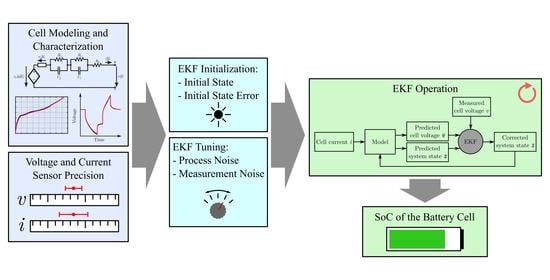Implementing an Extended Kalman Filter for SoC Estimation of a Li-Ion Battery with Hysteresis: A Step-by-Step Guide
Abstract
:1. Introduction
Structure of the Paper
2. Theory
2.1. Battery Model
2.2. Extended Kalman Filter for Battery SoC Estimation
3. Useful Extensions to the EKF Algorithm
3.1. Determination of the Process Noise from Parameter Errors
3.2. Current Error Contribution to the Process Noise
3.3. Initialisation
4. Cell Characterization
4.1. OCV Measurement
4.2. Model Parameter Identification
5. Step-by-Step Guide to Implementation
6. Experimental Validation
6.1. Experimental Setup
6.2. Evaluated Cell
6.3. Experiment Procedure
6.4. Comparative Analysis
- (E2)
- an EKF with a roughly tuned process noise matrix
- (E3)
- a Coulomb counter with the internal current sensor and the assumed capacity of .
- (E4)
- a Coulomb counter with the precise current sensor of the inverter and cell capacity correction.
6.5. Results
6.6. Discussion
6.6.1. Validity of the Reference
6.6.2. SoC Estimation Algorithms
7. Conclusions
8. Outlook
Author Contributions
Funding
Conflicts of Interest
Abbreviations
| BMS | Battery mangement system | ||
| EKF | Extended Kalman filter | ||
| LIB | Lithium ion battery | ||
| LUT | Lookup table | ||
| NMC | Nickel manganese cobalt | ||
| OCV | Open-circuit voltage | ||
| RC | resistor-capacitor | ||
| SoC | State of charge | ||
| Notation | |||
| sampling time | system state | ||
| k | timestep number: | input variable | |
| i | cell current ( for discharge) | measurement variable | |
| v | cell voltage | process noise | |
| coulombic efficiency | measurement noise | ||
| internal resistance | model parameters | ||
| resistance of the j-th RC element | input noise | ||
| capacitance of the j-th RC element | system state error | ||
| time constant of the j-th RC element | Kalman gain | ||
| M | max. hysteresis polarization voltage | linearization state/state | |
| hysteresis rate (unitless) | linearization state/input | ||
| cell capacity | linearization measurement/state | ||
| q | charge in the cell | measurement noise covariance | |
| z | state of charge (SoC): | process noise covariance | |
| open-circuit voltage (OCV) | parameter covariance | ||
| voltage at internal resistance | linearization state/parameters | ||
| voltage at the j-th RC element | input noise covariance | ||
| hysteresis voltage | standard deviation of x | ||
| x is a predicted value | |||
| x is a corrected value | |||
| resting time before initialization |
References
- Plett, G.L. Battery Management Systems, Volume I: Battery Modeling; Artech House: Norwood, MA, USA, 2015. [Google Scholar]
- Meng, J.; Luo, G.; Ricco, M.; Swierczynski, M.; Stroe, D.I.; Teodorescu, R. Overview of Lithium-Ion Battery Modeling Methods for State-of-Charge Estimation in Electrical Vehicles. Appl. Sci. 2018, 8, 659. [Google Scholar] [CrossRef] [Green Version]
- Shrivastava, P.; Soon, T.K.; Idris, M.Y.I.B.; Mekhilef, S. Overview of model-based online state-of-charge estimation using Kalman filter family for lithium-ion batteries. Renew. Sustain. Energy Rev. 2019, 113, 109233. [Google Scholar] [CrossRef]
- Ahmed, R.; Gazzarri, J.; Onori, S.; Habibi, S.; Jackey, R.; Rzemien, K.; Tjong, J.; LeSage, J. Model-based parameter identification of healthy and aged li-ion batteries for electric vehicle applications. SAE Int. J. Altern. Powertrains 2015, 4, 233–247. [Google Scholar] [CrossRef] [Green Version]
- Xing, Y.; He, W.; Pecht, M.; Tsui, K.L. State of charge estimation of lithium-ion batteries using the open-circuit voltage at various ambient temperatures. Appl. Energy 2014, 113, 106–115. [Google Scholar] [CrossRef]
- Hu, C.; Youn, B.D.; Chung, J. A multiscale framework with extended Kalman filter for lithium-ion battery SOC and capacity estimation. Appl. Energy 2012, 92, 694–704. [Google Scholar] [CrossRef]
- Ciortea, F.; Rusu, C.; Nemes, M.; Gatea, C. Extended kalman filter for state-of-charge estimation in electric vehicles battery packs. In Proceedings of the 2017 International Conference on Optimization of Electrical and Electronic Equipment (OPTIM) & 2017 Intl Aegean Conference on Electrical Machines and Power Electronics (ACEMP), Brasov, Romania, 25–27 May 2017; pp. 611–616. [Google Scholar]
- Wang, L.; Wang, L.; Liao, C. Research on improved EKF algorithm applied on estimate EV battery SOC. In Proceedings of the 2010 Asia-Pacific Power and Energy Engineering Conference, Chengdu, China, 28–31 March 2010; pp. 1–4. [Google Scholar]
- Hannan, M.A.; Lipu, M.H.; Hussain, A.; Mohamed, A. A review of lithium-ion battery state of charge estimation and management system in electric vehicle applications: Challenges and recommendations. Renew. Sustain. Energy Rev. 2017, 78, 834–854. [Google Scholar] [CrossRef]
- Chen, Z.; Fu, Y.; Mi, C.C. State of charge estimation of lithium-ion batteries in electric drive vehicles using extended Kalman filtering. IEEE Trans. Veh. Technol. 2012, 62, 1020–1030. [Google Scholar] [CrossRef]
- Zhang, F.; Liu, G.; Fang, L. A battery State of Charge estimation method with extended Kalman filter. In Proceedings of the 2008 IEEE/ASME International Conference on Advanced Intelligent Mechatronics, Xi’an, China, 2–5 July 2008; pp. 1008–1013. [Google Scholar]
- Jokić, I.; Zečević, Ž.; Krstajić, B. State-of-charge estimation of lithium-ion batteries using extended Kalman filter and unscented Kalman filter. In Proceedings of the 2018 23rd International Scientific-Professional Conference on Information Technology (IT), Zabljak, Montenegro, 19–24 February 2018; pp. 1–4. [Google Scholar]
- Lee, J.; Nam, O.; Cho, B. Li-ion battery SOC estimation method based on the reduced order extended Kalman filtering. J. Power Sources 2007, 174, 9–15. [Google Scholar] [CrossRef]
- He, H.; Xiong, R.; Zhang, X.; Sun, F.; Fan, J. State-of-charge estimation of the lithium-ion battery using an adaptive extended Kalman filter based on an improved Thevenin model. IEEE Trans. Veh. Technol. 2011, 60, 1461–1469. [Google Scholar]
- Sepasi, S.; Ghorbani, R.; Liaw, B.Y. Improved extended Kalman filter for state of charge estimation of battery pack. J. Power Sources 2014, 255, 368–376. [Google Scholar] [CrossRef]
- Hariharan, K.S.; Tagade, P.; Ramachandran, S. Mathematical Modeling of Lithium Batteries: From Electrochemical Models to State Estimator Algorithms; Springer International Publishing: Cham, Switzerland, 2017. [Google Scholar]
- Wei, Z.; He, H.; Pou, J.; Tsui, K.L.; Quan, Z.; Li, Y. Signal-Disturbance Interfacing Elimination for Unbiased Model Parameter Identification of Lithium-Ion Battery. IEEE Trans. Ind. Inform. 2020, 1. [Google Scholar] [CrossRef]
- Hu, J.; He, H.; Wei, Z.; Li, Y. Disturbance-Immune and Aging-Robust Internal Short Circuit Diagnostic for Lithium-Ion Battery. IEEE Trans. Ind. Electron. 2021, 1. [Google Scholar] [CrossRef]
- Zhou, D.; Yin, H.; Xie, W.; Fu, P.; Lu, W. Research on online capacity estimation of power battery based on ekf-gpr model. J. Chem. 2019, 2019, 5327319. [Google Scholar] [CrossRef] [Green Version]
- Diab, Y.; Auger, F.; Schaeffer, E.; Wahbeh, M. Estimating lithium-ion battery state of charge and parameters using a continuous-discrete extended kalman filter. Energies 2017, 10, 1075. [Google Scholar] [CrossRef] [Green Version]
- Bian, X.; Wei, Z.; He, J.; Yan, F.; Liu, L. A two-step parameter optimization method for low-order model-based state of charge estimation. IEEE Trans. Transp. Electrif. 2020, 7, 399–409. [Google Scholar] [CrossRef]
- Plett, G.L. Battery Management Systems, Volume II: Equivalent-Circuit Methods; Artech House: Norwood, MA, USA, 2015. [Google Scholar]
- Kalman, R.E. A New Approach to Linear Filtering and Prediction Problems. Trans. ASME J. Basic Eng. 1960, 82, 35–45. [Google Scholar] [CrossRef] [Green Version]
- Schneider, R.; Georgakis, C. How to not make the extended Kalman filter fail. Ind. Eng. Chem. Res. 2013, 52, 3354–3362. [Google Scholar] [CrossRef]
- Ma, W.; Qiu, J.; Liang, J.; Chen, B. Linear kalman filtering algorithm with noisy control input variable. IEEE Trans. Circuits Syst. II Express Briefs 2018, 66, 1282–1286. [Google Scholar] [CrossRef]
- Soto, A.; Berrueta, A.; Sanchis, P.; Ursúa, A. Analysis of the main battery characterization techniques and experimental comparison of commercial 18650 Li-ion cells. In Proceedings of the 2019 IEEE International Conference on Environment and Electrical Engineering and 2019 IEEE Industrial and Commercial Power Systems Europe (EEEIC/I&CPS Europe), Genova, Italy, 11–14 June 2019; pp. 1–6. [Google Scholar]
- Optimizing Nonlinear Functions. Available online: https://de.mathworks.com/help/matlab/math/optimizing-nonlinear-functions.html (accessed on 2 May 2021).

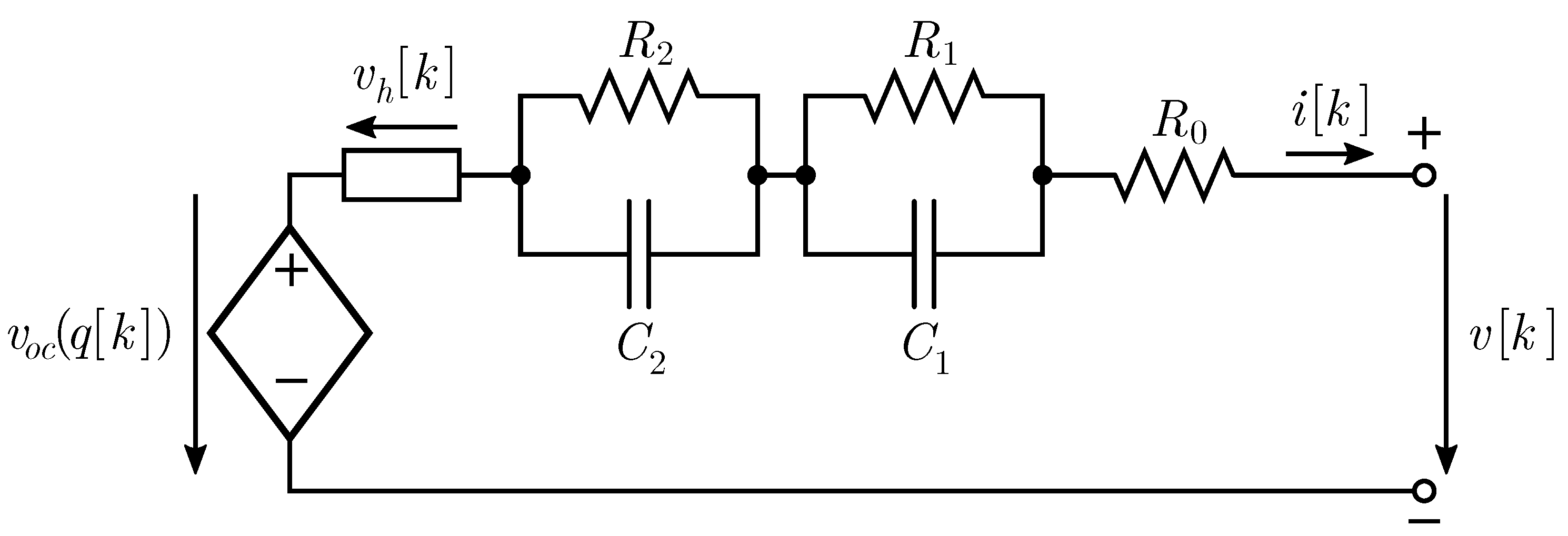



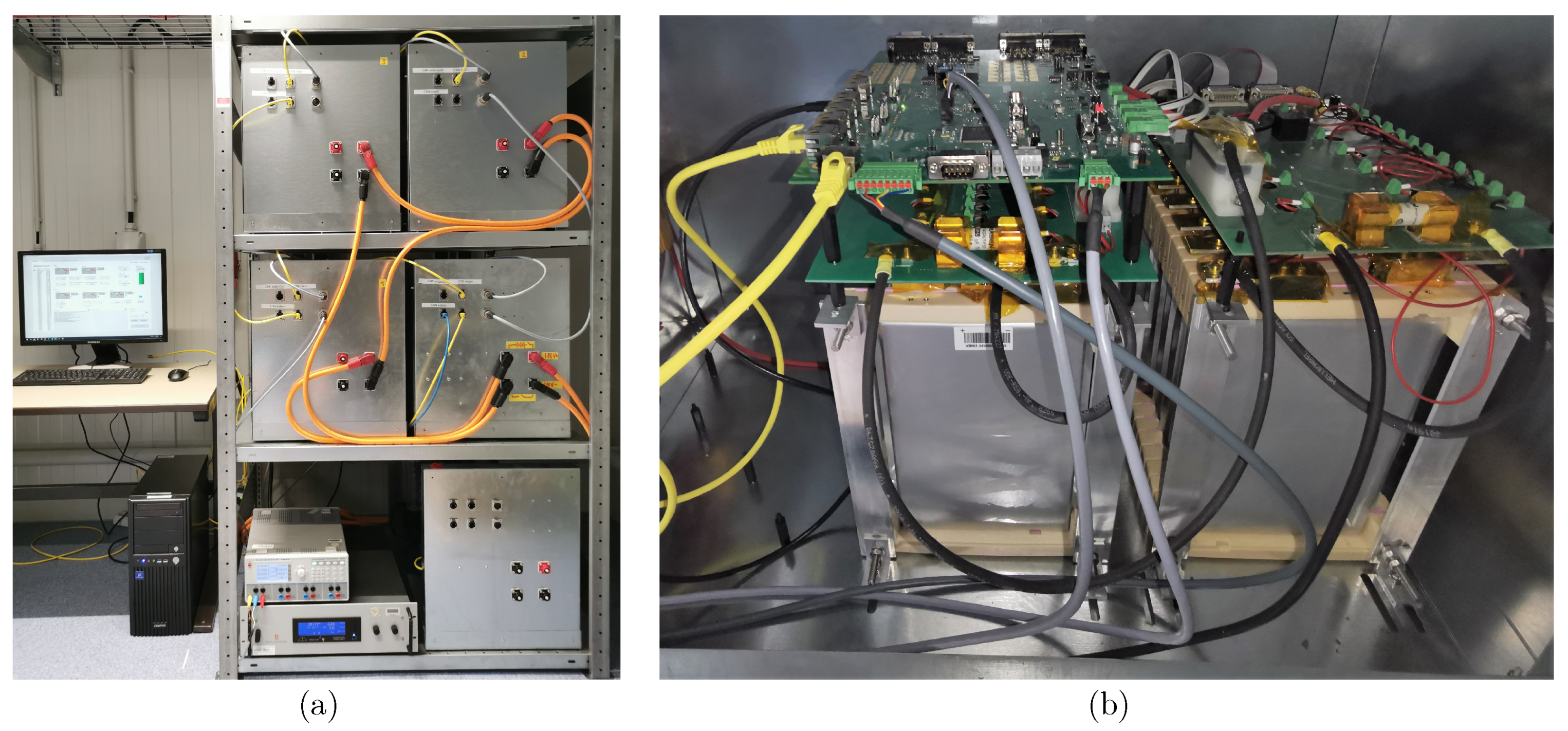

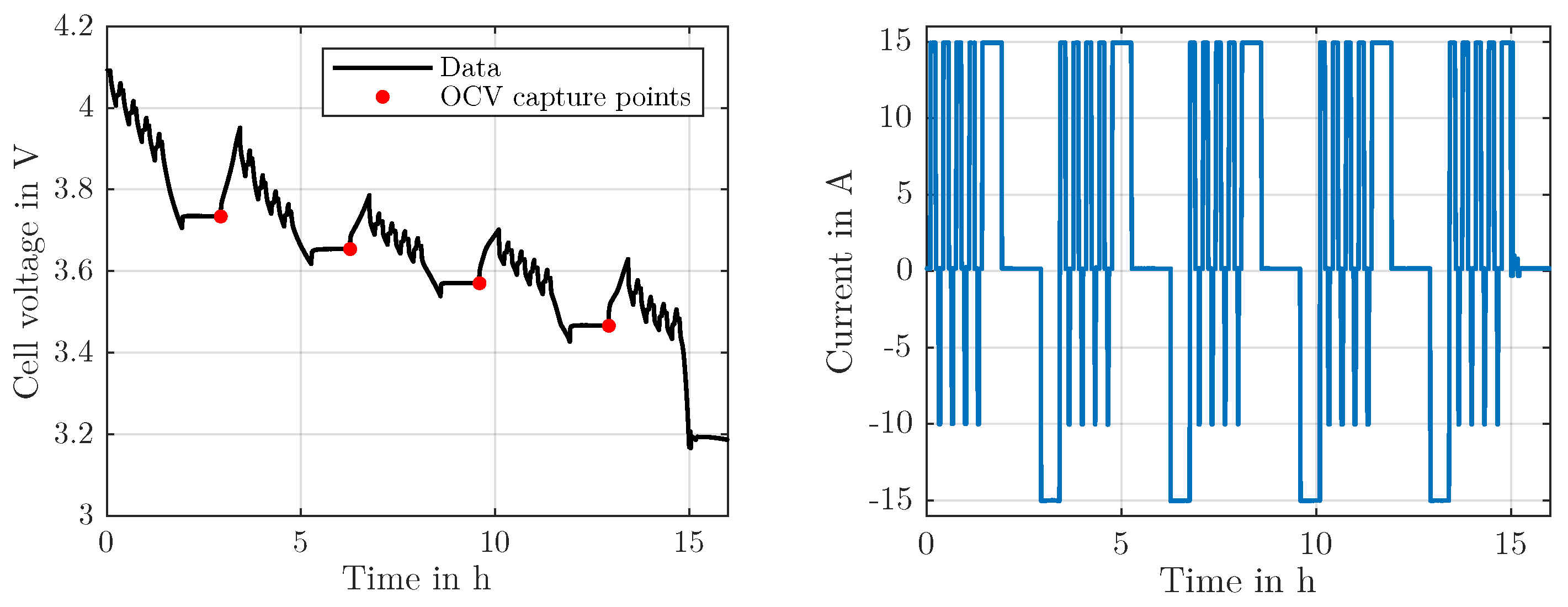
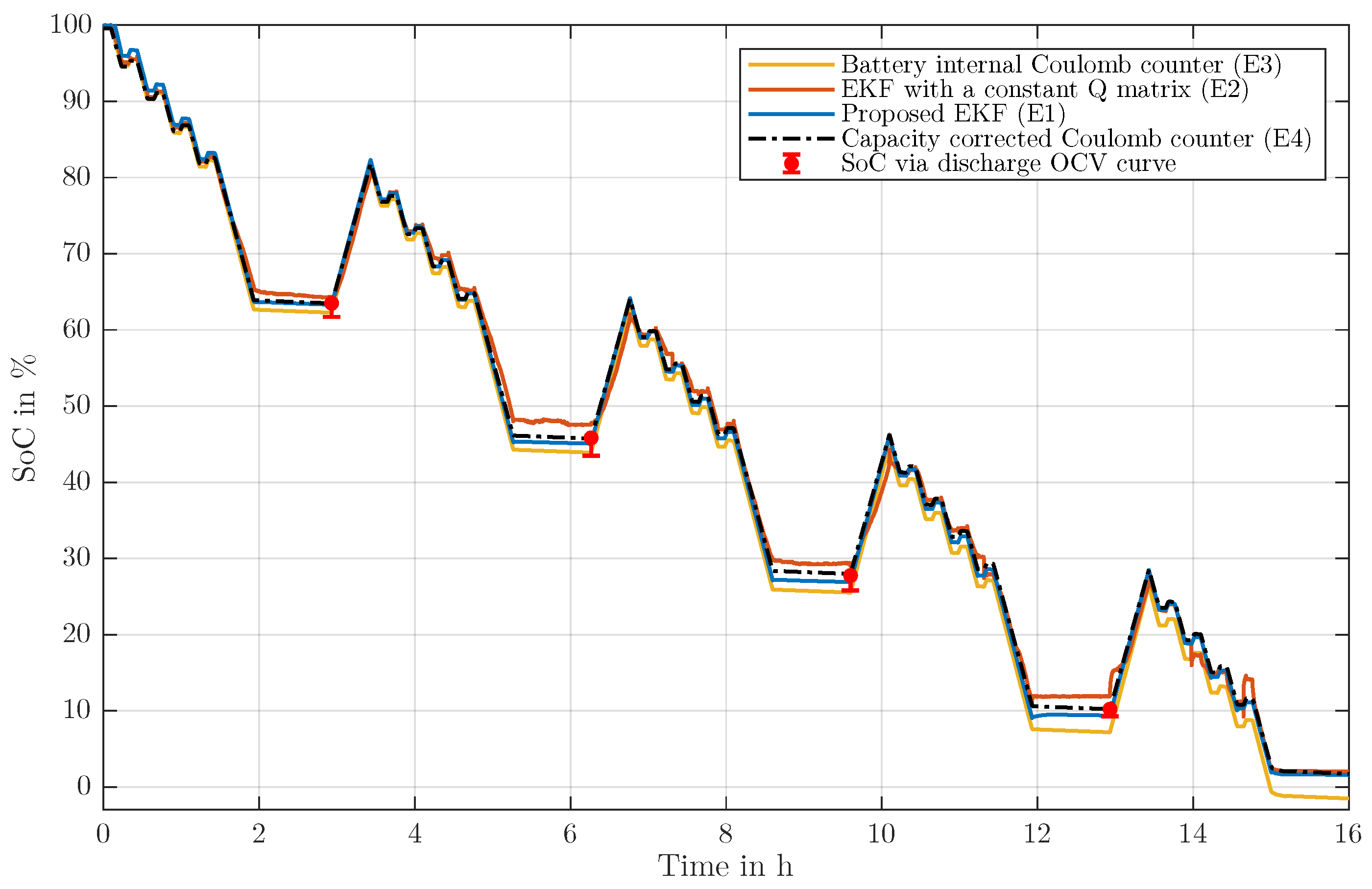

| Model Equations | |
| State equation: | |
| Measurement equation: | |
| 0. Initilization | |
| Initilization of the system state: | (see Section 3.3) |
| Initilization of the system state error: | (see Section 3.3) |
| 1. Prediction | |
| Prediction of the system state: | |
| Prediction of the system state error: | |
| Prediction of the measured value: | |
| Kalman gain: | |
| 2. Correction | |
| Correction of the system state: | |
| Correction of the system state error: | |
| Repeat 1. and 2. once per sampling interval | |
| General Description | Use Case: ECM |
|---|---|
| State eq. | Equations (2)–(5) |
| Measurement eq. | Equation (6) |
| System state | |
| Input/controller | |
| Measured variable | v |
Publisher’s Note: MDPI stays neutral with regard to jurisdictional claims in published maps and institutional affiliations. |
© 2021 by the authors. Licensee MDPI, Basel, Switzerland. This article is an open access article distributed under the terms and conditions of the Creative Commons Attribution (CC BY) license (https://creativecommons.org/licenses/by/4.0/).
Share and Cite
Rzepka, B.; Bischof, S.; Blank, T. Implementing an Extended Kalman Filter for SoC Estimation of a Li-Ion Battery with Hysteresis: A Step-by-Step Guide. Energies 2021, 14, 3733. https://doi.org/10.3390/en14133733
Rzepka B, Bischof S, Blank T. Implementing an Extended Kalman Filter for SoC Estimation of a Li-Ion Battery with Hysteresis: A Step-by-Step Guide. Energies. 2021; 14(13):3733. https://doi.org/10.3390/en14133733
Chicago/Turabian StyleRzepka, Benedikt, Simon Bischof, and Thomas Blank. 2021. "Implementing an Extended Kalman Filter for SoC Estimation of a Li-Ion Battery with Hysteresis: A Step-by-Step Guide" Energies 14, no. 13: 3733. https://doi.org/10.3390/en14133733





